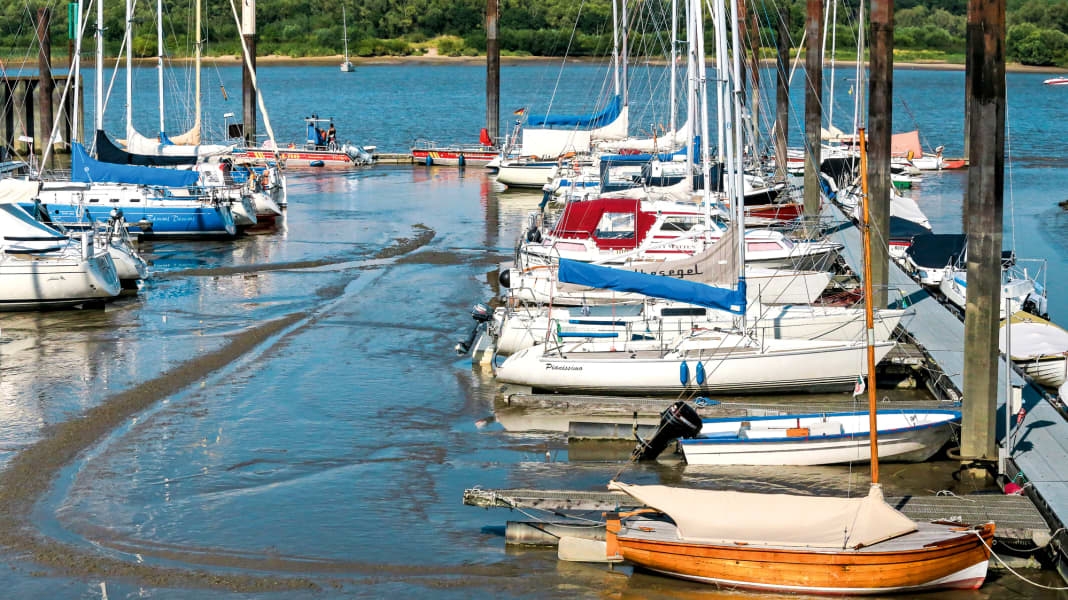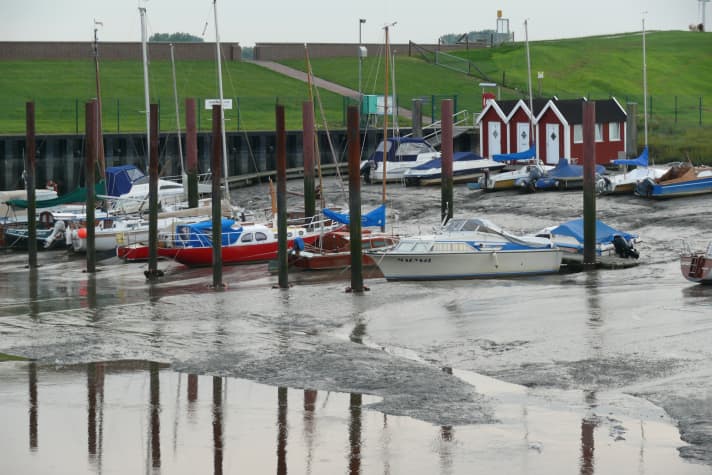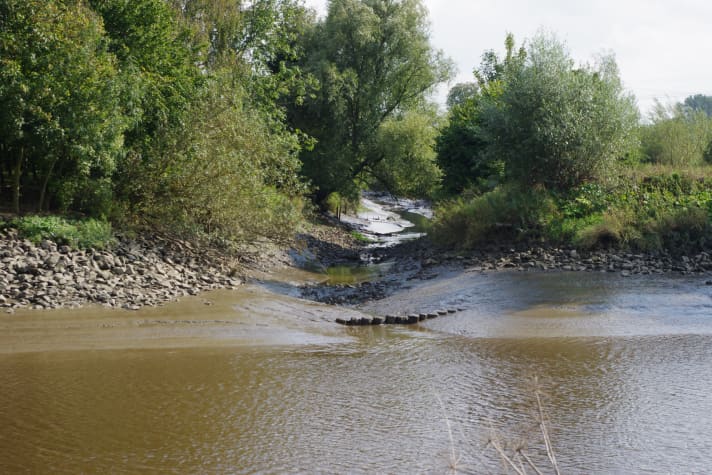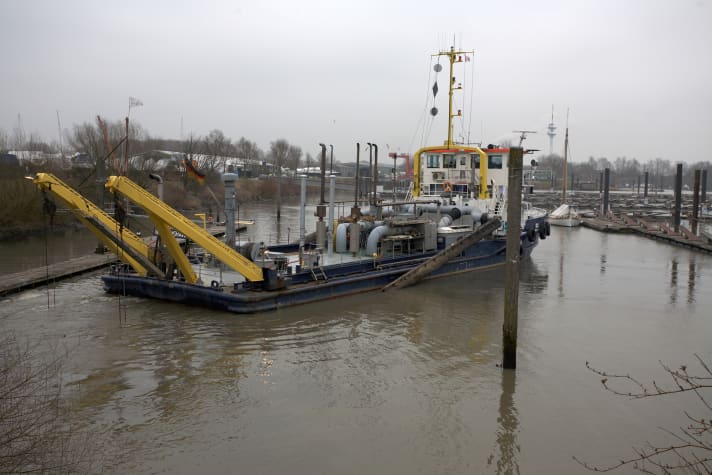Lower Elbe sailing area: Worries at the start of the season - sailors fight against siltation in their harbours
Nils Leiterholt
· 29.02.2024

It is an exciting picture for sailors who have little experience in tidal areas: The boats in the harbour are not in the water, but in the mud. Even the access road is not navigable by boat, everything has dried up, with only small, stream-like veins of water still making their way through. The idea of being able to set sail again in a few hours seems bizarre, but it is a reality for the sailors here.
Since the deepening of the Elbe, however, the operators of the marinas along the Elbe have had major problems keeping the harbours navigable even at high tide. This requires a great deal of voluntary commitment from many small clubs. And in some places, those affected are wondering how much longer the harbours can be operated at all.
At the Sportschipper Verein Borsfleth members are already fighting for their season, against sediment and time. The start of the season is getting closer and closer, and there is a regulation stating that work on the harbour bottom may only be carried out up to a certain date. At SSV, the members themselves are pitching in and have built their own flushing ship, the "Swan of Borsfleth", during the coronavirus pandemic.
Support from the Elbe Silt Fund
Ludger Walterbusch, first chairman of SSV Borsfleth, is also endeavouring to gain support from the Schleswig-Holstein state government. "So far, we haven't received any support from the state government in Kiel," he says. In the run-up to the deepening of the Elbe, however, the "Elbe Sludge Fund" was set up and Hamburg paid a basic amount of ten million euros into it, the interest on which was intended to compensate the harbours for the consequences of the deepening of the Elbe. "From this, we receive a subsidy of 30 per cent of the net sum of the pure dredging or flushing work," explains Walterbusch.
The SSV receives just under 6,000 euros a year from the fund. The hourly rate per labourer, which an ordinary member has to pay for each hour of work not carried out, serves as the basis for calculating the cost of washing up. In the case of the Borsfleth association, this is 25 euros; a professional labour hour is of course significantly more expensive, but there was no support from the fund for the self-construction. "The 30 per cent of the net sum is helpful, but in no way compensates for the additional work we have to do because of the deepening of the Elbe," criticises Ludger Walterbusch.

Since the last deepening of the Elbe, Walterbusch says, the siltation has become much more severe than before. "Before, it was enough to have the harbour flushed every three years, now we have to flush it every year and much more," he says. In addition, the current speed has become much faster since the attempt to make the Elbe passable for ships with a draught of up to 14.5 metres. As a result, much coarser sediment is also transported. "The grain size of the silt we have in the harbour is getting coarser. The coarser the grain size of the silt, the heavier a grain is and the more difficult it is to get rid of it again using the water injection process," explains the first chairman.
Silt fall area at buoy E3 off Heligoland
In the agreement "Joint key points of Hamburg and Schleswig-Holstein for the future shipment of sediments in the E3 tonne" from April 2023, the two federal states have defined the framework conditions for the dumping of silt in the so-called silt fall area at buoy E3 off Helgoland. There, the silt from the dredging work will be returned to the water along the entire Elbe.

Among other things, the key points stipulate that Hamburg is to pay seven euros per tonne of dry substance, i.e. less the weight of the water in the silt, to the state of Schleswig-Holstein. One euro of this is to be used to "reduce the increasing siltation at Schleswig-Holstein moorings (harbours (state, municipal and private), marinas, other businesses) on the Tidal Elbe and its tributaries". The money would therefore be available to all harbour operators in Schleswig-Holstein from Wedel to the mouth of the Elbe. However, none of this money has yet reached them, reports Walterbusch.
Clubs like the one in Borsfleth are supported by the Nedderelv Group e. V.an association of water sports clubs on the Lower Elbe that represents their common interests. The group's environmental protection officer is Uwe Hanse. He has been dealing with the effects of the deepening of the Elbe for years, pointing out many problems and, not least, repeatedly pointing the finger of blame at the Schleswig-Holstein state government.
Money should help - but does not arrive
It receives up to 1.5 million euros a year from Hamburg earmarked for the maintenance of the moorings on the Tidal Elbe and its tributaries, which it has simply retained until now. "This is a huge sham," says Uwe Hanse, commenting clearly on the state government's approach, "I was also told on the phone that the Minister of Finance and Deputy Prime Minister of Schleswig-Holstein is sitting on empty coffers, this can't be true, the money is earmarked!"
In the past, so-called silt harrowing was used as a measure against siltation. However, this is no longer common practice, as the heavy sediments, such as sand bodies, form a hard bed, which then has to be removed by professionals at great expense. Instead, the water injection method is now used on the Elbe.
Water is forced into the silt by a pump through many nozzles, causing the silt to swell slightly, become liquid and then flow into deeper areas. This has less to do with the current, i.e. the draining water, and more to do with gravity, which causes the swollen silt to look for deeper points to flow to.

In Borsfleth, however, flushing is only permitted six hours after high water, i.e. only when the water is running out. In Schleswig-Holstein, for environmental reasons, flushing is only permitted up to a maximum water temperature of twelve degrees. This has been considered in Schleswig-Holstein because a few sediments are always stirred up during flushing and these draw the oxygen out of the water from a water temperature of 12 degrees and thus deprive the fish of their livelihood.
Three federal states - three regulations
There is no such regulation in Lower Saxony and Hamburg. "The regulation in Schleswig-Holstein seems implausible to me if dredging is even allowed around the clock, 365 days a year, less than 100 metres from Glückstadt or Borsfleth as the crow flies," says Uwe Hanse from the Nedderelv group's board.
In Borsfleth, flushing is now underway with the self-built water injection device (WIG) "Swan of Borsfleth". Fortunately, the association still had the pump for the WIG on land, but the rest of the material for building the flushing device had to be purchased from scratch. In total, over 1,200 hours of labour were required to complete the "Swan of Borsfleth". The floating pontoon is equipped with a pump and a flushing bar and is pushed by a push boat.

"To start, the water has to be pumped up with a hand pump, and when the pump is full, the engine can be started. Then you can sail very slowly through the harbour for six hours from high tide," explains the first chairman of the SSV. The flushing bar is driven just five centimetres above the silt, is around 6.5 metres wide and has 63 nozzles pointing downwards. The pump pumps 700 cubic metres of water per hour through the flushing bar and pushes it through the nozzles into the silt.
As at least two people are always needed to wash up and at least 425 hours a year must now be spent washing up, at least 850 additional working hours per year are required for the washing-up process alone, not including preparation and follow-up work. "With this commitment, we can still guarantee the appropriate depths on 1/3 of the berths, continue to manage them and also continue to serve as a weekend idyll for our Hamburg guests," says Ludger Walterbusch.
Major concerns about the harbours
Nevertheless, he is very concerned about the continued existence and profitability of the harbour operations: "As an association, I can of course calculate differently than a commercial operator, for example, but I can't see any way forward if the state government in Kiel doesn't finally support us. Then things could get tight for us too."
Nevertheless, he is looking forward to the 2024 season: "Thanks to the commitment of the members, I can look forward to another great season this year, and Borsfleth is already looking forward to welcoming many guest sailors!"

